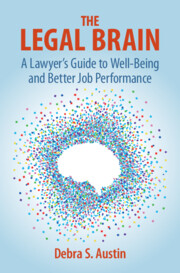Book contents
- The Legal Brain
- The Legal Brain
- Copyright page
- Dedication
- Contents
- Acknowledgments
- Introduction
- 1 The Impaired Lawyer
- 2 The Spectrum from Languishing to Flourishing
- 3 The Lawyering Culture
- 4 The Lawyer’s Brain
- 5 Memory, Knowledge, and Building Expertise
- 6 Motivation, Reward, and Developing Habits
- 7 The Impact of Stress
- 8 The Influence of Self-Medication
- 9 The Importance of Fuel
- 10 Optimizing Brain Health
- 11 Enhancing Mental Strength
- 12 Developing an Action Plan for the Neuro-intelligent Lawyer
- 13 The Neuro-intelligent Legal Organization
- Conclusion
- Select Bibliography
- Index
8 - The Influence of Self-Medication
Published online by Cambridge University Press: 08 May 2024
- The Legal Brain
- The Legal Brain
- Copyright page
- Dedication
- Contents
- Acknowledgments
- Introduction
- 1 The Impaired Lawyer
- 2 The Spectrum from Languishing to Flourishing
- 3 The Lawyering Culture
- 4 The Lawyer’s Brain
- 5 Memory, Knowledge, and Building Expertise
- 6 Motivation, Reward, and Developing Habits
- 7 The Impact of Stress
- 8 The Influence of Self-Medication
- 9 The Importance of Fuel
- 10 Optimizing Brain Health
- 11 Enhancing Mental Strength
- 12 Developing an Action Plan for the Neuro-intelligent Lawyer
- 13 The Neuro-intelligent Legal Organization
- Conclusion
- Select Bibliography
- Index
Summary
Substance use among lawyers is a common way to self-medicate stress, anxiety, and depression and to fuel overwork. To facilitate an understanding of how substances of abuse work in the brain, it is helpful to grasp the basics of neurotransmission. Information travels through the brain via chains of neurons. This information is an electrical impulse while in the brain cell, but to travel across the gap between neurons, the information uses chemicals called neurotransmitters. The site of action for self-medicating substances is at that gap, which is called a synapse. Different substances cause various changes in the brain by influencing the synapses of those lawyers who use them. These drugs are divided by substances that stimulate and can fuel overwork (caffeine, nicotine, amphetamine, cocaine) and sedatives that can calm stress and anxiety (alcohol, cannabis, opioids). Some lawyers use prescribed antidepressant medications. All of them impact the brain at the gap between brain cells, the synapse, where communication involves neurotransmitters and their receptors.
Keywords
- Type
- Chapter
- Information
- The Legal BrainA Lawyer's Guide to Well-Being and Better Job Performance, pp. 88 - 111Publisher: Cambridge University PressPrint publication year: 2024

